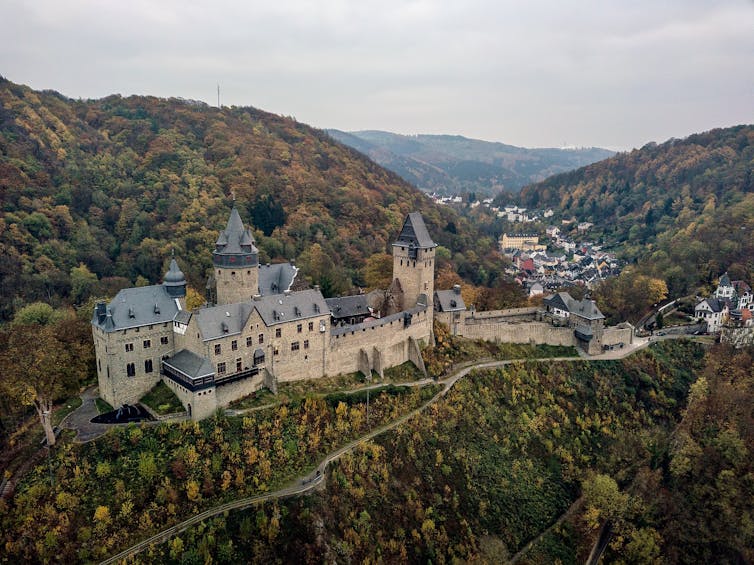When the New Zealand branch of the Youth Hostel Association (YHA) collapsed in 2021 and the country’s 11 hostels were forced to close, staff and punters alike were shocked. General manager Simon Cartwright cited the pandemic as the primary cause of the downturn in tourism revenues and the association’s financial woes. “YHA,” he said, “has been a cornerstone of youth travel in New Zealand for 89 years”.
Similar feelings of nostalgia and sadness have beset generations of intrepid domestic travellers in the UK, since the England and Wales branch of the association announced, in June 2023, that it would be selling off 20 of its remaining 150 hostels. “Is there any map symbol more reassuring to a wet and weary walker,” asked one journalist bemoaning this news, than the YHA’s “red triangle?” What will those weary walkers do without them, was their worry.
YHA hostels were once celebrated as the very antithesis of the hotel. They were communal spaces catering to young people on small budgets.
My research shows that a thriving backpacking hostel ignites authentic, spontaneous interactions between strangers. A genuine sense of camaraderie – that transcends backgrounds, borders and cultures – can be fostered within its bounds.
A potted history of the youth hostel
Two Germans, Richard Shirrmann, a teacher, and Wilhelm Münker, a conservationist, are credited with founding the first youth hostel, in Germany, in 1912. Shirrmann had been taking his students on hiking trips, as part of the long-standing German tradition of Wanderlust, along the Rhine river, organising temporary local accommodation along the way.
The Hungarian tourism scholar Gabriella Nagy recounts how during one particular eight-day excursion, his group got caught in a storm and were refused shelter by a farmer. Spending the night in a school, instead, Shirrmann dreamed up the idea of every village having “a friendly youth hostel”, as he later wrote, to “welcome all young Germans who loved walking”.
Several experiments later, Shirrmann opened a permanent facility in the Burg Altena, in North Rhine-Westphalia. Rooms in this 12th-century castle were furnished with triple bunk beds. You could wash and cook on site. You could also gather in the common rooms to sing and talk and play. This system pioneered the principles of self-help and cooperation that would go on to characterise the youth hostel movement.

Burg Altena, North Rhine-Westphalia. Kateryna Baiduzha|Wikimedia, CC BY-SA
Schirrmann’s concept of creating a network of safe and welcoming places for young travellers led to the establishment of the Deutsches Jugendherbergswerk (German Youth Hostel Association) in 1919. The idea made its way across Europe and the Channel. And in 1930, the Youth Hostel Association (YHA) was established in England and Wales. The stated purpose was: “To help all, but especially young people, to a greater knowledge, use and love of the countryside, particularly by providing hostels or other accommodation for them on their travels.”
Research has shown how the movement’s romantic, anti-urban ideals found echoes within British walking and back-to-the-land traditions. In 1939, the England and Wales branch of the YHA had expanded to 300 hostels. And after the second world war, support from the Ministry of Education saw it grow to over 200,000 members by 1950.
1960s counterculture: a challenge the movement
During what British cultural historian Arthur Marwick has called the “long sixties”, the profound shifts that reshaped western European and north American societal attitudes led to an explosion of youth travel across the world. YHA hostels, though, could not keep up.
With hostel stays largely structured around booze bans, curfews and chores, the YHA appeared old-fashioned and out of date. By contrast, a new, more commercially focused breed of hostels was emerging that understood young travellers’ changing needs.
Independent guesthouses and hostels emerged on the hippie trail, including the Pudding Shop in Istanbul and Mumbai’s New Vasantashram. They offered visitors greater freedom and more privacy, with longer opening hours and more flexible sleeping arrangements. On site, travellers could buy cheap food, bus tickets, packaged trips and tours, alcohol and even hashish.
The independent hostel continued to evolve. During the 1980s, Australian establishments started catering specifically to international budget backpackers. These were designed to provide a more relaxed stay – with communal areas, bars, cinema rooms and spaces for working, eating and hanging out together. The concept then made its way across Europe, Asia, South America and the UK.
The YHA, however, continued to struggle to keep up with the times. Today, it faces considerable financial and market pressure. The brand remains largely invisible to many travellers, as entrepreneurs, venture capitalists, hotel groups and hostel chains drive innovation and development.
Unlike hotels, which prioritise convenience and comfort, a hostel is what sociologist Ray Oldenburg terms a “third place”. It is designed to be fun, to foster connection and interaction, to offer both escape and sociability. Oldenburg suggests that in order to facilitate this kind of conviviality and playfulness – a space for community and conversations without purpose – you need an “appreciation of human personality and individuality”.
For the YHA to find relevance, it could renew its focus on the outdoors. It could better cater to wild campers, solo travellers, touring cyclists and “van-lifers” – those who share a deep passion for exploration and adventure. Crucially, its hostels could play a key role in blurring class lines and connecting us to both each other and the places we visit.



 Maersk Vessel Successfully Transits Red Sea After Nearly Two Years Amid Ongoing Security Concerns
Maersk Vessel Successfully Transits Red Sea After Nearly Two Years Amid Ongoing Security Concerns  Sanofi’s Efdoralprin Alfa Gains EMA Orphan Status for Rare Lung Disease
Sanofi’s Efdoralprin Alfa Gains EMA Orphan Status for Rare Lung Disease  Apple Explores India for iPhone Chip Assembly as Manufacturing Push Accelerates
Apple Explores India for iPhone Chip Assembly as Manufacturing Push Accelerates  Harris Associates Open to Revised Paramount Skydance Bid for Warner Bros Discovery
Harris Associates Open to Revised Paramount Skydance Bid for Warner Bros Discovery  LG Energy Solution Shares Slide After Ford Cancels EV Battery Supply Deal
LG Energy Solution Shares Slide After Ford Cancels EV Battery Supply Deal  Trump Administration Reviews Nvidia H200 Chip Sales to China, Marking Major Shift in U.S. AI Export Policy
Trump Administration Reviews Nvidia H200 Chip Sales to China, Marking Major Shift in U.S. AI Export Policy  Blackstone Leads $400 Million Funding Round in Cyera at $9 Billion Valuation
Blackstone Leads $400 Million Funding Round in Cyera at $9 Billion Valuation  noyb Files GDPR Complaints Against TikTok, Grindr, and AppsFlyer Over Alleged Illegal Data Tracking.
noyb Files GDPR Complaints Against TikTok, Grindr, and AppsFlyer Over Alleged Illegal Data Tracking.  Elliott Management Takes $1 Billion Stake in Lululemon, Pushes for Leadership Change
Elliott Management Takes $1 Billion Stake in Lululemon, Pushes for Leadership Change  FedEx Beats Q2 Earnings Expectations, Raises Full-Year Outlook Despite Stock Dip
FedEx Beats Q2 Earnings Expectations, Raises Full-Year Outlook Despite Stock Dip  Oracle Stock Slides After Blue Owl Exit Report, Company Says Michigan Data Center Talks Remain on Track
Oracle Stock Slides After Blue Owl Exit Report, Company Says Michigan Data Center Talks Remain on Track  Volaris and Viva Agree to Merge, Creating Mexico’s Largest Low-Cost Airline Group
Volaris and Viva Agree to Merge, Creating Mexico’s Largest Low-Cost Airline Group  Citi Appoints Ryan Ellis as Head of Markets Sales for Australia and New Zealand
Citi Appoints Ryan Ellis as Head of Markets Sales for Australia and New Zealand  Toyota to Sell U.S.-Made Camry, Highlander, and Tundra in Japan From 2026 to Ease Trade Tensions
Toyota to Sell U.S.-Made Camry, Highlander, and Tundra in Japan From 2026 to Ease Trade Tensions  Union-Aligned Investors Question Amazon, Walmart and Alphabet on Trump Immigration Policies
Union-Aligned Investors Question Amazon, Walmart and Alphabet on Trump Immigration Policies  Treasury Wine Estates Shares Plunge on Earnings Warning Amid U.S. and China Weakness
Treasury Wine Estates Shares Plunge on Earnings Warning Amid U.S. and China Weakness 































